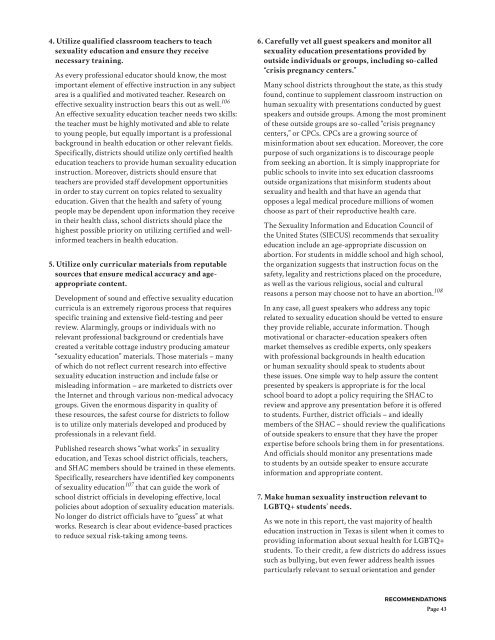Conspiracy of Silence
tfn-sex-ed-report-2016-web
tfn-sex-ed-report-2016-web
Create successful ePaper yourself
Turn your PDF publications into a flip-book with our unique Google optimized e-Paper software.
4. Utilize qualified classroom teachers to teach<br />
sexuality education and ensure they receive<br />
necessary training.<br />
As every pr<strong>of</strong>essional educator should know, the most<br />
important element <strong>of</strong> effective instruction in any subject<br />
area is a qualified and motivated teacher. Research on<br />
effective sexuality instruction bears this out as well. 106<br />
An effective sexuality education teacher needs two skills:<br />
the teacher must be highly motivated and able to relate<br />
to young people, but equally important is a pr<strong>of</strong>essional<br />
background in health education or other relevant fields.<br />
Specifically, districts should utilize only certified health<br />
education teachers to provide human sexuality education<br />
instruction. Moreover, districts should ensure that<br />
teachers are provided staff development opportunities<br />
in order to stay current on topics related to sexuality<br />
education. Given that the health and safety <strong>of</strong> young<br />
people may be dependent upon information they receive<br />
in their health class, school districts should place the<br />
highest possible priority on utilizing certified and wellinformed<br />
teachers in health education.<br />
5. Utilize only curricular materials from reputable<br />
sources that ensure medical accuracy and ageappropriate<br />
content.<br />
Development <strong>of</strong> sound and effective sexuality education<br />
curricula is an extremely rigorous process that requires<br />
specific training and extensive field-testing and peer<br />
review. Alarmingly, groups or individuals with no<br />
relevant pr<strong>of</strong>essional background or credentials have<br />
created a veritable cottage industry producing amateur<br />
“sexuality education” materials. Those materials – many<br />
<strong>of</strong> which do not reflect current research into effective<br />
sexuality education instruction and include false or<br />
misleading information – are marketed to districts over<br />
the Internet and through various non-medical advocacy<br />
groups. Given the enormous disparity in quality <strong>of</strong><br />
these resources, the safest course for districts to follow<br />
is to utilize only materials developed and produced by<br />
pr<strong>of</strong>essionals in a relevant field.<br />
Published research shows “what works” in sexuality<br />
education, and Texas school district <strong>of</strong>ficials, teachers,<br />
and SHAC members should be trained in these elements.<br />
Specifically, researchers have identified key components<br />
<strong>of</strong> sexuality education 107 that can guide the work <strong>of</strong><br />
school district <strong>of</strong>ficials in developing effective, local<br />
policies about adoption <strong>of</strong> sexuality education materials.<br />
No longer do district <strong>of</strong>ficials have to “guess” at what<br />
works. Research is clear about evidence-based practices<br />
to reduce sexual risk-taking among teens.<br />
6. Carefully vet all guest speakers and monitor all<br />
sexuality education presentations provided by<br />
outside individuals or groups, including so-called<br />
“crisis pregnancy centers.”<br />
Many school districts throughout the state, as this study<br />
found, continue to supplement classroom instruction on<br />
human sexuality with presentations conducted by guest<br />
speakers and outside groups. Among the most prominent<br />
<strong>of</strong> these outside groups are so-called “crisis pregnancy<br />
centers,” or CPCs. CPCs are a growing source <strong>of</strong><br />
misinformation about sex education. Moreover, the core<br />
purpose <strong>of</strong> such organizations is to discourage people<br />
from seeking an abortion. It is simply inappropriate for<br />
public schools to invite into sex education classrooms<br />
outside organizations that misinform students about<br />
sexuality and health and that have an agenda that<br />
opposes a legal medical procedure millions <strong>of</strong> women<br />
choose as part <strong>of</strong> their reproductive health care.<br />
The Sexuality Information and Education Council <strong>of</strong><br />
the United States (SIECUS) recommends that sexuality<br />
education include an age-appropriate discussion on<br />
abortion. For students in middle school and high school,<br />
the organization suggests that instruction focus on the<br />
safety, legality and restrictions placed on the procedure,<br />
as well as the various religious, social and cultural<br />
reasons a person may choose not to have an abortion. 108<br />
In any case, all guest speakers who address any topic<br />
related to sexuality education should be vetted to ensure<br />
they provide reliable, accurate information. Though<br />
motivational or character-education speakers <strong>of</strong>ten<br />
market themselves as credible experts, only speakers<br />
with pr<strong>of</strong>essional backgrounds in health education<br />
or human sexuality should speak to students about<br />
these issues. One simple way to help assure the content<br />
presented by speakers is appropriate is for the local<br />
school board to adopt a policy requiring the SHAC to<br />
review and approve any presentation before it is <strong>of</strong>fered<br />
to students. Further, district <strong>of</strong>ficials – and ideally<br />
members <strong>of</strong> the SHAC – should review the qualifications<br />
<strong>of</strong> outside speakers to ensure that they have the proper<br />
expertise before schools bring them in for presentations.<br />
And <strong>of</strong>ficials should monitor any presentations made<br />
to students by an outside speaker to ensure accurate<br />
information and appropriate content.<br />
7. Make human sexuality instruction relevant to<br />
LGBTQ+ students’ needs.<br />
As we note in this report, the vast majority <strong>of</strong> health<br />
education instruction in Texas is silent when it comes to<br />
providing information about sexual health for LGBTQ+<br />
students. To their credit, a few districts do address issues<br />
such as bullying, but even fewer address health issues<br />
particularly relevant to sexual orientation and gender<br />
RECOMMENDATIONS<br />
Page 43


